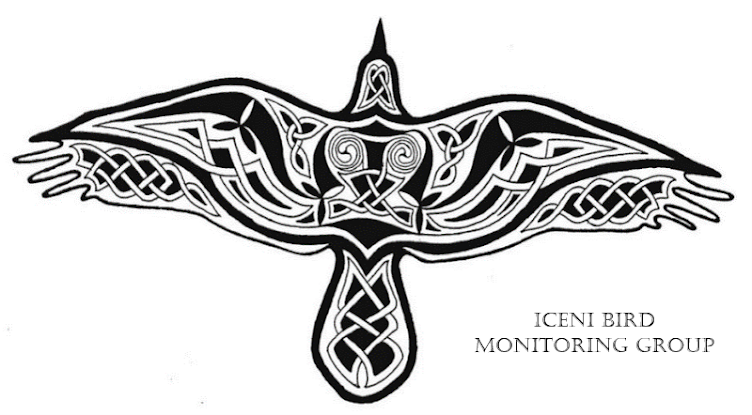Our Projects
In addition to monitoring the birds at sites on behalf of our conservation partners, we also run a number of colour-ringing projects and support other ringers whose work in undertaken within Norfolk. Where the species receives special protection under the Wildlife & Countryside Act, all projects on these species are undertaken under the appropriate schedule 1 licence. If you see any birds from any of these projects please report online via our reporting portal -
Iceni Birding Monitoring Group - sightings
These projects are:
North Norfolk Black-headed Gull project
Red darvic with white number 2 plus a letter & 2 numbers - 2C00-99 & 2H00-99.
The Black-headed project aims to establish where our breeding birds go post breeding season, and where our wintering birds originate from. What are these two population's migration routes? Data on this species has increased as a result of its susceptibility to avian flu, and ringing will aid track the potential long term effects of avian influenza, on this species, in the future.
UK conservation status: Amber
North Norfolk Mediterranean Gull project
Yellow darvic with black numbers (4) - 2100-99.
The project aims to establish where our breeding birds go post breeding season? Do they all return back to Norfolk bred or move to other colonies?
North Norfolk Little Tern project
The project is being run in conjunction with the National Trust with the primary aim to monitor the breeding success of birds on Blakeney Point, the return rate of juveniles as adults in subsequent years, their dispersal to other breeding sites, longevity and migration movements.
North Norfolk Sandwich Tern project
UK conservation status: Amber
North Norfolk Oystercatcher project
Green darvic with 2 white numbers - C00 to 99, plus a single orange project marker.
The project is being run in conjunction with a number of farms and other bodies with the primary aim to monitor the breeding success of birds on the Norfolk coast, the return rate of juveniles as adults in subsequent years, their dispersal to other breeding sites, longevity and migration movements. Oystercatcher chick productivity (survival) has declined over recent years.
UK conservation status: Amber
North Norfolk Lapwing project
Blue darvic with 2 white numbers - 00 to 99, plus a single red project marker.
The project primarily aims to monitor fledging success and adult return rates to the natal area. Currently a number of wader species in Norfolk struggle with productivity levels and in the light of these concerns, the study will inform on potential long term effects for this species. Productivity (chick survival) has declined over recent years.
North Norfolk coastal town Turnstone project
Red darvic with 3 white letters starting with J - JAA to JYY, plus a single black project marker
The project aims to establish whether the North Norfolk wintering Turnstones return every year to the same seaside town, whether there are inter location movements and what are their migration routes and summer breeding areas. This is a particular area of interest, as one bird, JAA, was originally ringed in Arctic Canada, though it is not anticipated that this is the origin of all the birds, and we would like to establish whether it returns to Canada every year or goes elsewhere, and where potentially the other birds that are part of the winter flock originate from.
UK conservation status: Amber
White darvic with 2 black numbers - 00-99
National Water Pipit project
Yellow darvic with a black number & letter - 0A to 9Z -
The Water Pipit project has been running since 2018. The birds are attitudinal migrants, arriving in the UK in September and staying until April. The current estimate is that around 200 birds spend the winter mainly in southern and eastern areas. Over 40 birds have been individually marked with yellow darvic rings with a two character numeric alpha code. This collaborative approach, with groups and individuals across the country contributing to the efforts to discover more about these birds, has already proven the extreme site faithfulness of this wintering species. It is still unknown precisely where our birds breed and spend the summer, although it is suspected to be the Pyrenees. There has only ever been one UK ringed Water Pipit re-trapped abroad, in the Netherlands while on passage.
Our project aims to gain more knowledge on their site fidelity, longevity and migration routes, and hopefully establish the UK Water Pipit breeding areas.
Report sightings to icenibmg@gmail.com
East Anglia Swan project
Orange darvic with 1 black number plus 3 letters - 4 (i.e. 4AAA)
The East Anglia swan project has been running for a number of years and covers East Anglia, the Home Counties, London, and parts of the South-east. It is a long term study of Mute Swan movements in South Central England, and has an increased importance again as a result of this species susceptibility to avian flu. If you see any of these marked birds please email details to mike.reed2017@outlook.com

UK conservation status: N/A
Green or Orange wing tags with either 2 letters or numbers (Marsh Harrier)
The East Anglia Raptor project. The project's main focus is Marsh Harriers, but also looks at Common Buzzard and Red Kites. The aim is to monitor raptor brood sizes, fledging rates, and post breeding movements. This is undertaken by the North West Norfolk RG and if you see any of these please email location, code and date to harriermanphil@gmail.com



.JPG)





